In the dynamic landscape of the modern era, the significance of Internet statistics is undeniable. They provide a window into the intricate realm of digital trends and user behaviors, offering valuable insights for data-driven decision-making by businesses and policymakers alike. As the Internet continues to reshape society and the economy, its impact resonates across diverse sectors, propelling a digital transformation that transcends boundaries.
From revolutionizing retail experiences to redefining entertainment consumption and enhancing educational paradigms, the Internet catalyzes innovation and economic growth. This transformation is epitomized by the thriving realms of e-commerce and digital services, which have redefined the scope of possibilities, fostering a new era of connectivity and opportunity.
Global Internet Usage Trends
Overall Growth of Internet Users
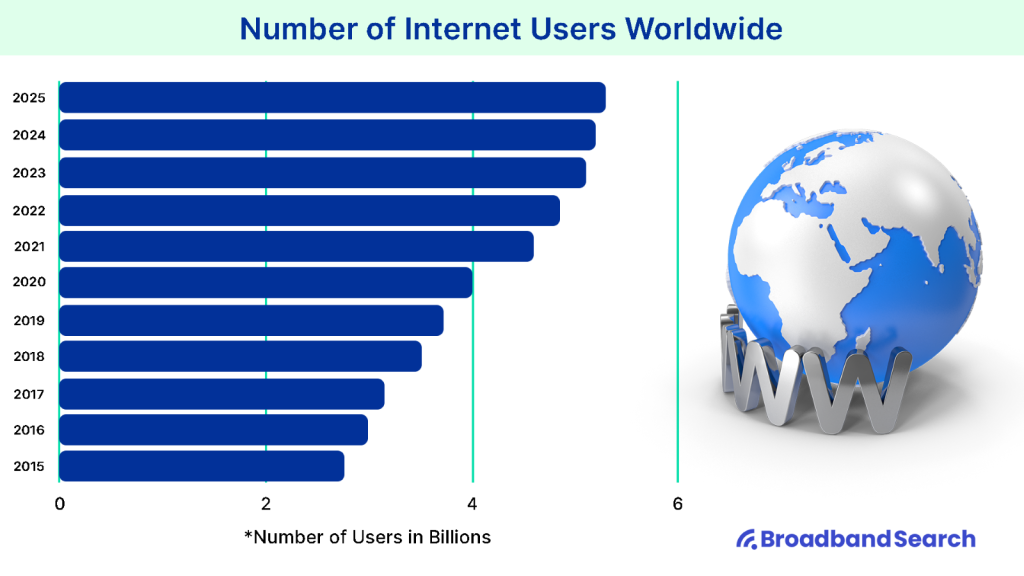
The expansion of the Internet user base has been a remarkable journey, with historical data showing a transformative shift from limited access to widespread connectivity. The latest data shows over 5.3 billion active Internet users globally, representing approximately 66% of the global population. Factors like increased affordability of devices, improved infrastructure, and innovative services drive this growth.
Regional Distribution of Internet Users
The digital landscape presents an intriguing tapestry of Internet usage across diverse regions and populations:
- China is home to over 1.05 billion Internet users, with a penetration rate of 75.12%.
- India has seen significant uptake, with 55.9% of the population, or 755 million users, now online.
- The U.S. retains high penetration, with 94.5% of its population (approximately 314.2 million people) actively using the Internet.
- East Asia accounts for 25% of global users, maintaining its dominance.
- Northern Europe leads with the world's highest penetration rate, at 98%.
- Asia overall continues to dominate with 58.3% of global Internet users.
- South Africa dedicates an average of 10 hours daily to Internet use, highlighting deep online engagement.
- East Africa still lags, with only 25.6% penetration, signaling ongoing barriers to accessibility.
Age and Gender Demographics of Internet Users
Internet usage patterns exhibit distinct trends across different age groups and gender identities, shedding light on generational preferences and gender-based digital behaviors.
Age groups and their online presence
In 2021, a notable trend emerged in the digital world, highlighting the influence of age on online presence. The age group spanning 25 to 34 years stood out as the largest contingent of online users worldwide, constituting a significant one-third of the digital population. Notably, those aged 18 to 24 years accounted for 18 percent of global online users, signifying active digital exploration.
In parallel, individuals aged 65 and older represented approximately 6 %of the global Internet user base, showcasing a diverse spectrum of digital adoption.
Across all global regions, the age bracket between 15 and 24 demonstrated heightened digital connectivity, with 77% actively using the Internet as of 2025. This surpassed the rest of the population by 12 percentage points, underlining the pronounced role of this demographic in shaping contemporary cyberspace.
Gender-based usage patterns
As of last year, Internet engagement showcases distinct gender-based trends. Notably, internet usage among males is now at 69%, and females at 64.5%, revealing a slight but noteworthy closing of the gender gap.
Examining these patterns closely, women tend to leverage social media platforms for socializing, sharing, and community building. In contrast, men lean towards technology, gaming, and professional networking content. These patterns reflect evolving preferences within the digital sphere, aligning with broader societal changes and efforts toward inclusivity.
Mobile Internet Usage
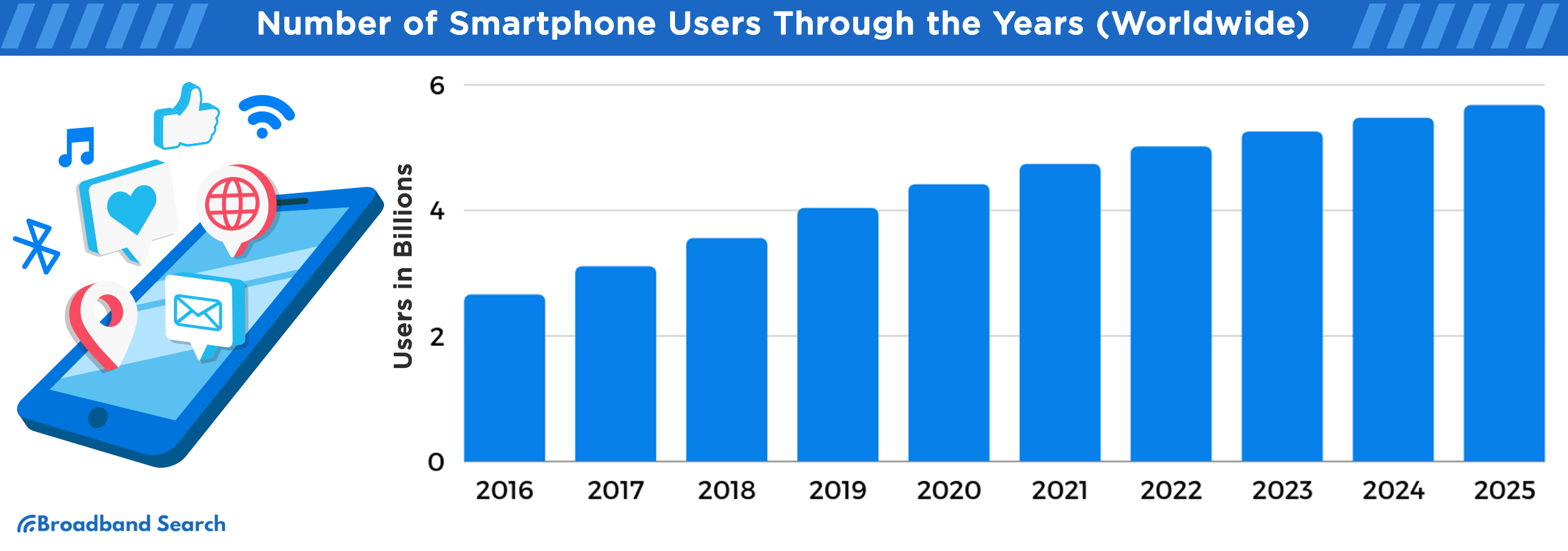
Rise of Mobile Devices
The ascent of mobile devices has fundamentally transformed our virtual world. Smartphone adoption has skyrocketed to over 5.55 billion smartphone users globally, showcasing remarkable growth that stems from the availability of budget-friendly options.
Smartphone Adoption Rates: The accessibility of affordable smartphones has played a pivotal role in this surge. Developing markets, in particular, have witnessed a surge in smartphone ownership, democratizing access to the digital realm for millions.
Tablets and Other Mobile Gadgets: In addition to smartphones, the rise of portable computing devices like tablets has further expanded mobile internet usage. Tablets offer a versatile platform for various tasks, from content consumption to productivity, catering to a broad spectrum of user needs.
Mobile Internet vs. Fixed-line Internet
The competition between mobile and fixed-line Internet has reshaped how we connect, communicate, and access information.
Accessibility and Convenience: Mobile Internet has effectively addressed the connectivity divide in remote and underserved areas, circumventing the challenges of establishing fixed-line infrastructure. Global mobile connections currently stand at approximately 11 billion, surpassing the world's population by 2.46 billion connections – a 37% margin of mobile connections over the global populace.
Data Usage Trends: The surge in mobile data usage is evident in the rise of streaming services, app usage, and evolving data consumption patterns. Video streaming accounts for 66% of mobile data traffic, with users spending around 112 minutes per day on mobile apps.
Streaming: Video streaming platforms like YouTube and Netflix have revolutionized entertainment consumption. Over 90% of global internet users stream videos on mobile devices, reflecting the dominance of mobile streaming.
App Usage: Mobile apps have become integral to our daily routines, with an average of 9-10 mobile apps used per day and 30 per month per user. Messaging apps, social media, and productivity tools drive this trend.
Data Consumption Patterns: Data-hungry applications and content, such as high-definition videos and multimedia-rich apps, contribute to the exponential growth of mobile data consumption. Monthly data usage per smartphone user can range from 5GB to 10GB in developed countries, reflecting the diverse ways mobile data is utilized.
Internet Connection Technologies

Broadband Adoption
Internet speeds have undergone a remarkable transformation, progressing from the early days of dial-up connections to the era of gigabit fiber-optic networks.
DSL, Cable, Fiber-Optic, and Satellite Connections
Evolution of Internet Speeds: Dial-up connections, which once operated at a mere 56 kbps, have been outpaced by DSL with speeds reaching 100 Mbps. Cable connections offer even greater capacity, with speeds ranging from 100 Mbps to 1 Gbps. Fiber-optic networks lead the pack, with gigabit speeds becoming increasingly commonplace, propelling data transmission at an astonishing 1,000 Mbps.
Role of Infrastructure Investment: The expansion of broadband access owes much to sustained infrastructure investment. Governments, telecommunication companies, and private entities have collectively poured resources into deploying and upgrading networks, enabling wider access to high-speed Internet services, particularly in urban centers.
Rural vs. Urban Connectivity
Urban Advantages: Urban areas revel in the advantages of high-speed Internet options that cater to the demands of modern digital life. The virtual landscape in cities is characterized by not only swift access but also an array of digital services, educational opportunities, and advanced applications that enhance daily living.
Rural Challenges: In contrast, rural regions grapple with limited Internet options, often falling victim to the digital divide. The absence of robust infrastructure and geographical challenges contribute to slower connectivity speeds, affecting educational access, economic opportunities, and overall quality of life.
5G Deployment and Impact
Faster Speeds and Low Latency
Potential for Real-Time Applications: 5G technology ushers in faster speeds and remarkably low latency, setting the stage for transformative real-time applications. Industries such as IoT (Internet of Things) stand to benefit immensely, as the low latency enables seamless communication between interconnected devices. This is particularly critical for applications like autonomous vehicles, telemedicine, and industrial automation, where split-second decisions are essential.
Enhanced User Experience: 5G's exceptional speed and low latency translate into enhanced user experiences. High-definition streaming, online gaming without lag, and immersive virtual reality experiences become more accessible. This heightened connectivity redefines the boundaries of what users can achieve, offering previously unattainable levels of interactivity and engagement.
Potential for IoT and Smart Cities
Massive Device Connectivity: 5G's capacity for massive device connectivity paves the way for the proliferation of IoT devices. The seamless interconnectivity of sensors, wearables, and smart appliances has become a reality. This enables data-driven insights, efficient automation, and innovative services that can enhance daily living and business operations.
Smart City Initiatives: 5G plays a pivotal role in the realization of smart cities. The technology's low latency and high bandwidth empower urban planners to optimize traffic management, reduce energy consumption, and enhance public safety. The synergy between 5G and IoT facilitates the creation of sustainable, efficient, and interconnected urban ecosystems that benefit citizens and the environment alike.
Social Media and Online Communication
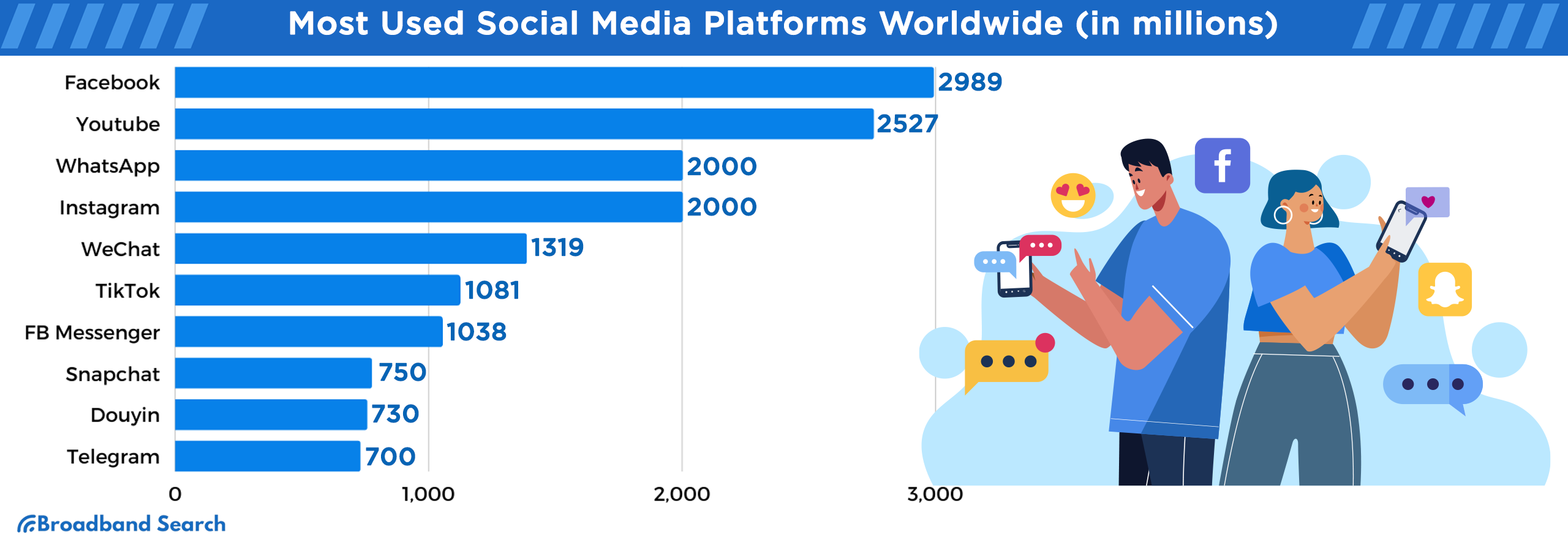
Embedded deeply in modern life, social media forms an integral part of our daily interactions, shaping communication patterns, connecting global communities, and influencing how we express ourselves in the virtual world.
Social Media Usage Statistics
Popular Platforms and Their User Base Percentage
Facebook: Maintaining its stronghold in the social media realm, Facebook boasts a staggering 3.07 billion monthly active users (MAU) as of 2025. A noteworthy 2.11 billion users engage with the platform on a daily basis (DAU), signifying that 68.73% of its monthly active users are committed daily participants. DemandSage notes that Facebook is still the top social media platform and is expected to surpass 3.1 billion monthly active users by 2027.
Instagram: With an impressive user base exceeding 2 billion monthly active individuals, Instagram captivates a youthful audience through its visual-centric approach, with 62.3% of users being between 18 and 34 years old. While the text states it's poised to exceed 2.5 billion users by the close of last year, other estimates place the figure at 2 billion in 2025. DataReportal notes that 41.1% of the world's internet users (people aged 13+) were reached by Instagram ads at the beginning of 2025.
X (formerly Twitter): Serving as a hub for real-time updates, news sharing, and public discussions, X maintains a user base of 611 million monthly active users globally in 2025. According to Owlead, over 245 million users log in daily. The platform reaches about 12.6% of all internet users worldwide. While the text states 237.8 million monetizable daily active users, other sources indicate this figure as the last official number released in Q2 2022, and the platform has since stopped releasing quarterly reports. X has a younger user base, with nearly 70% of users falling in the 18-34 age group. The platform is also notable for the gender disparity among its users, with a male-dominated user base of around 64%.
| Platform | Monthly Active Users (MAU) | Daily Active Users (DAU) | DAU as % of MAU | Key Demographics / Notes |
|---|---|---|---|---|
| 3.07 B (2025) | 2.11 B | 68.73% | Top social media platform; projected >3.1 B MAU by 2027 | |
| 2 B (2025) | N/A | N/A | 62.3% users aged 18–34; reached 41.1% of internet users via ads | |
| X (Twitter) | 611 M | 245 M | 40.1% approx | 70% users aged 18–34; 64% male; real-time updates &s; discussions; reaches 12.6% of global internet users |
Online Communication Trends
Messaging Apps, Email, and Video Conferencing
Shift from Traditional Email to Real-Time Messaging: Real-time messaging apps like WhatsApp, WeChat, and Messenger have redefined communication. According to the latest data, WhatsApp reported 2.7 billion users, WeChat reached 1.671 billion, and Messenger had 1.3 billion monthly users. These apps have supplanted traditional email due to their immediacy and accessibility.
Video Conferencing's Role in Remote Work and Virtual Meetings: Video conferencing platforms like Zoom and Microsoft Teams have gained prominence, particularly during the COVID-19 pandemic. Zoom's daily participants surged to 300 million, showcasing the pivotal role video conferencing plays in remote work, virtual events, and communication across geographical boundaries.
Shifts in Communication Preferences
Visual Communication: Emojis, GIFs, and Stickers: Visual elements have become integral to digital communication. Emojis, GIFs, and stickers serve as expressive tools, conveying emotions and nuances that text alone might struggle to capture. Approximately 95% of internet users have used emojis, exemplifying their universal appeal.
Evolving Language: Text-Speak, Abbreviations, and Internet Slang: The digital sphere has cultivated its language, marked by abbreviations like "LOL," "BRB," and a myriad of internet slang. This linguistic evolution reflects the informal and fast-paced nature of online conversations, fostering a shared sense of identity among internet users.
E-Commerce and Online Transactions
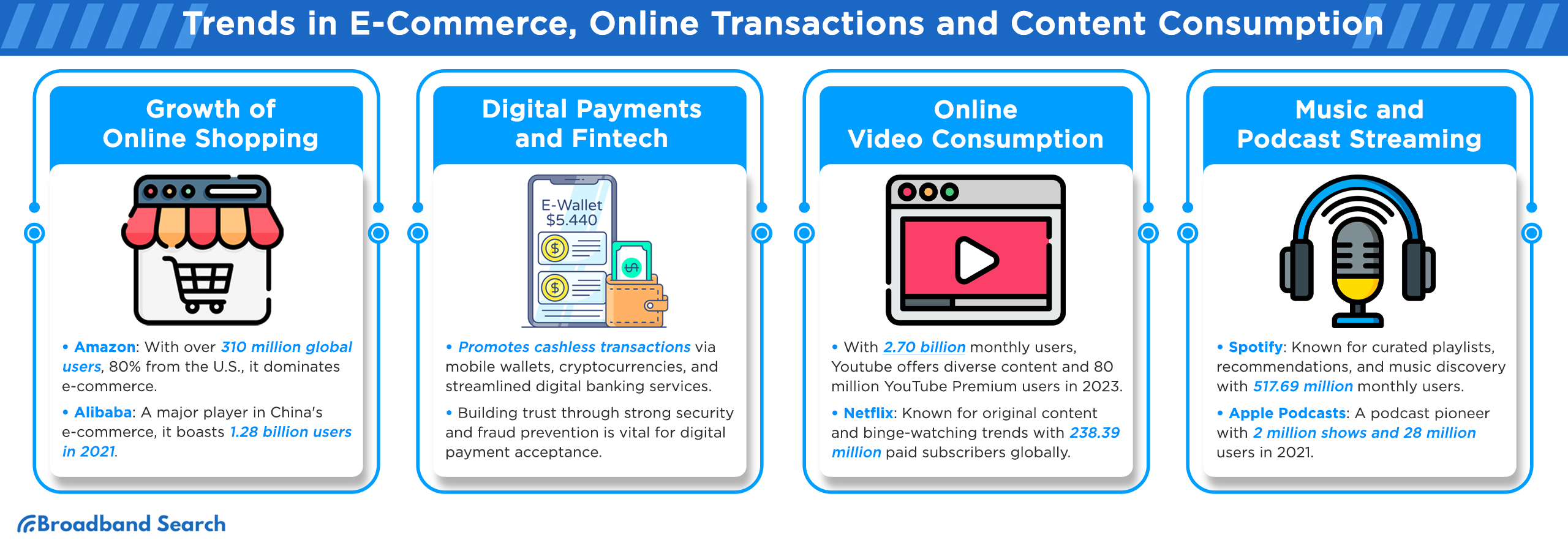
Growth of Online Shopping
Amazon: Within the e-commerce domain, Amazon's influence remains formidable, anchored by its substantial user base. Estimates for 2025 suggest a global user base of approximately 321 million, according to Analyzer.Tools. Of these, the majority, over 230 million customers, are from the United States. Amazon's transformative impact extends beyond online retail, extending its reach into the realm of cloud services through Amazon Web Services (AWS), which accounted for 16% of Amazon's overall revenue in 2024.
Alibaba: Alibaba, a powerhouse in China's e-commerce landscape, has a vast global influence as well. Its active users on China retail marketplaces reached 903 million as of July 26, 2022. While precise recent global figures are not available, it continues to hold a significant position in the e-commerce and cloud computing sectors, with revenue of CN¥941.168 billion (US$130.35 billion) in 2024. The company's success extends beyond traditional e-commerce, encompassing a range of digital services and technological innovations, including Alibaba Cloud, which is a significant player in the cloud computing market.
| Metric / Platform | Amazon | Alibaba |
|---|---|---|
| Global Active Users | 321 M (2025) | N/A (recent global data unavailable) |
| Country-Specific Users | 230 M in the U.S. | 903 M in China (July 2022) |
| Revenue (2024) | N/A for global breakdown; AWS 16% of total revenue | CN¥941.168 B (US$130.35 B) |
| Cloud Presence | Amazon Web Services (AWS) – major revenue driver | Alibaba Cloud – major cloud player in Asia &s; growing globally |
| Key Notes | Global e-commerce leader; diverse services beyond retail | Dominant in Chinese e-commerce; diversified digital ecosystem |
Digital Payments and Fintech
Mobile Wallets, Cryptocurrencies, and Digital Banking
Cashless Transactions: The digital evolution has catalyzed a shift towards cashless transactions. Mobile wallets like PayPal, Apple Pay, and Google Pay offer convenient and secure payment methods. Cryptocurrencies, led by Bitcoin, introduce decentralized digital currencies that further disrupt traditional financial systems. Moreover, digital banking services streamline financial activities, from money transfers to investment management.
Security Concerns and Adoption Barriers
Trust and Fraud Prevention: While the benefits of digital payments are immense, security concerns remain a critical consideration. Users often hesitate due to worries about data breaches, identity theft, and fraudulent activities. Building trust through robust security measures and fraud prevention mechanisms is crucial to fostering the widespread adoption of digital payment methods.
Content Consumption and Streaming
Online Video Consumption
YouTube: On the international stage, YouTube stands tall, celebrated for its eclectic content spectrum. As of 2025, the platform surpassed 2.70 billion monthly logged-in users, the platform resonates with a diverse audience, catering to tutorials, reviews, entertainment, and user-generated content enthusiasts. In the realm of YouTube Premium, last year the platform surpassed over 100 million active users globally.
A staggering 52% of internet users venture onto YouTube's domain at least once a month, underscoring its universal appeal. Daily, the platform records a remarkable influx of over 122 million visitors, engaging with its immersive offerings via both its website and dedicated apps.
Netflix: At the forefront of the streaming landscape, Netflix stands as an influential player, enthralling viewers with its original content and cultivating the pervasive binge-watching phenomenon. Renowned as a premier subscription-based streaming service, Netflix's reach extends around the globe, boasting an impressive 301.6 million paid subscribers as of last year.
Music and Podcast Streaming
Spotify: Reshaping music consumption, Spotify's user-focused attributes fuel engagement. As of Q2 2025, Spotify counts 696 million monthly active users globally, including 276 million paid subscribers. This represents a significant increase in users and subscribers over the previous year. Curated playlists, personalized recommendations, and music discovery mechanisms underscore its role as a hub for auditory exploration.
Apple Podcasts: Apple Podcasts, a pioneer in the podcasting realm, has fostered a rich ecosystem for content creators and listeners alike. With millions of shows available, the platform's user base enjoys diverse content offerings. As of 2021, Apple Podcasts commands a robust following, with over 2 million shows and 28 million registered users, contributing to the ongoing podcasting revolution.
Internet of Things (IoT)
The Internet of Things (IoT) has seamlessly integrated into daily lives, connecting a multitude of devices and enabling automation, data-driven insights, and enhanced convenience across various domains.
Connected Devices and Smart Technology
Growth of IoT Devices
Smart Home Gadgets, Wearables, Industrial Sensors: The IoT landscape encompassed around 16.6 billion interconnected devices by the end of 2024, marking a 15% increase over 2023. This is nearly double the global population. Amidst this scenario, smart home elements like thermostats, lighting, and voice assistants intertwine seamlessly. Wearables, embracing fitness trackers and smartwatches, captivate widespread interest. Meanwhile, IoT sensors in the industrial sector diligently oversee equipment performance, amplifying efficiency and curtailing downtime. 72% of industrial companies are already implementing IoT strategies.
Predicted Increase in Connected Devices and Their Applications: Projections indicate that IoT device deployment will continue to surge to 40 billion devices by 2030. Industries spanning healthcare, agriculture, and manufacturing are embracing IoT applications, offering enhanced efficiency, predictive insights, and data-driven decision-making.
Applications in Smart Homes, Healthcare, and Industry
Automation, Monitoring: IoT's transformative potential is evident in its applications. Smart homes leverage automation, allowing users to control devices remotely for enhanced convenience. In healthcare, IoT enables remote patient monitoring, enhancing care quality and reducing hospitalizations. Industries utilize IoT for predictive maintenance, and optimizing machinery performance.
Smart Appliances, Remote Patient Monitoring, Predictive Maintenance: Smart appliances, embedded with IoT technology, redefine daily routines. Remote patient monitoring via wearable devices fosters proactive healthcare management. Predictive maintenance employs IoT sensors to predict equipment failures, curbing downtime and boosting productivity.
Data Collection and Privacy Challenges
Ethical Considerations: As IoT proliferation continues, ethical considerations emerge. Balancing convenience with data privacy is paramount. Addressing concerns about consent, data ownership, and ethical AI applications in IoT scenarios is pivotal to responsible implementation.
Security Measures: To safeguard IoT ecosystems, security measures are imperative. Encryption, secure boot mechanisms, and over-the-air updates are integral to securing devices. Implementing best practices ensures protection against potential vulnerabilities and cyber threats that could compromise data integrity and user safety.
Future Trends and Predictions
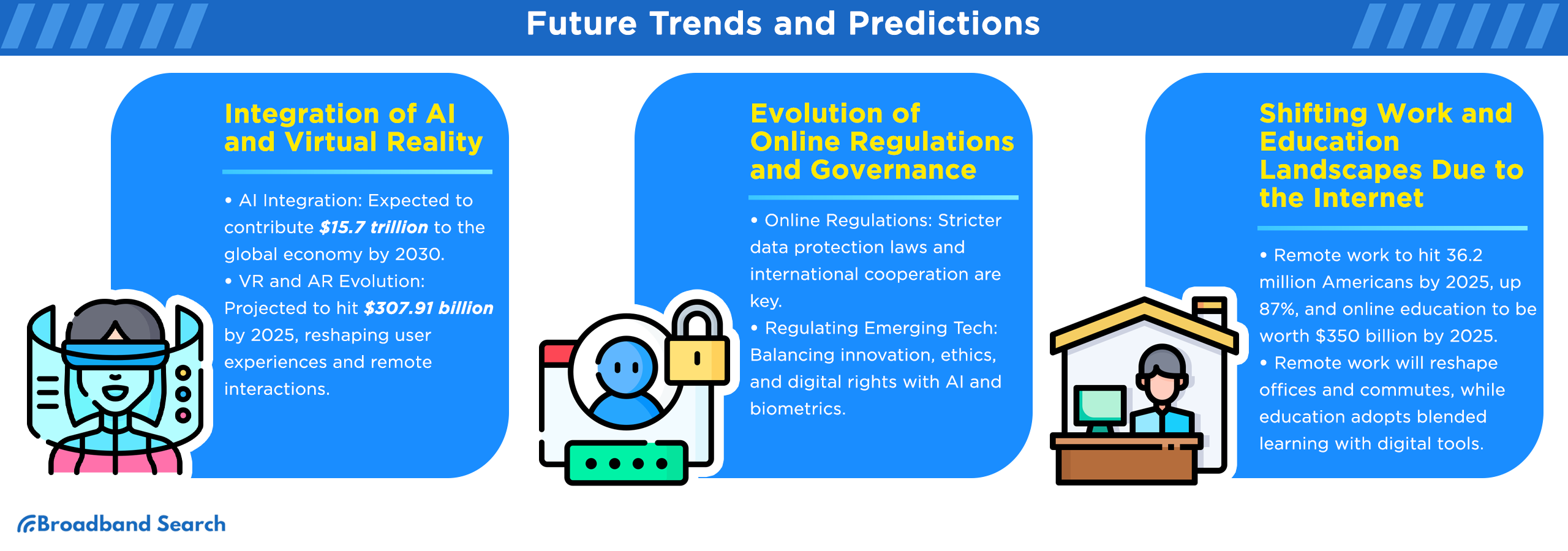
Integration of AI and Virtual Reality
AI-Driven Services and Automation Across Industries: The integration of AI is poised to revolutionize industries, enhancing productivity and insights. By 2030, AI is predicted to contribute over $15.7 trillion to the global economy. Automation and predictive analytics are anticipated to reshape sectors ranging from healthcare to manufacturing.
VR and AR Enhancing User Experiences and Remote Interactions: The evolution of virtual and augmented reality holds transformative potential for user engagement. By 2025, the AR & VR market is projected to reach $46.6 billion in B2C revenue. Another estimate puts the global AR and VR headsets market size at $16.90 billion in 2025. These technologies will redefine remote collaboration, immersive training, and interactive consumer experiences.
Evolution of Online Regulations and Governance
Strengthening Data Protection Laws and International Cooperation: The digital era calls for robust data protection measures. Stricter regulations like the General Data Protection Regulation (GDPR) are anticipated to evolve, safeguarding user privacy. International collaboration is essential to address cross-border data concerns.
Challenges of Regulating Emerging Technologies and Digital Rights: Emerging technologies, including AI and biometrics, pose regulatory challenges. Balancing innovation with ethical considerations and preserving digital rights will be a complex endeavor for policymakers.
Shifting Work and Education Landscapes Due to the Internet
Remote Work and Online Learning Trends: The transformative influence of the Internet on work and education is set to persist. Upwork estimates that 32.6 million Americans will work remotely by the end of 2025, representing 22% of the workforce. Gallup research from May 2025 shows that 51% of remote-capable employees are working in a hybrid environment. The online education market is also poised for significant growth, with projections suggesting it could reach $1,124.79 billion by 2030.
Impact on Office Spaces, Commuting, and Traditional Education Models: Internet-enabled remote work will influence office space designs and commuting patterns. Traditional education models will evolve, with blended learning approaches incorporating digital tools and resources to enhance student outcomes.
The Bottom Line
The landscape of internet statistics is a testament to the rapid evolution and widespread integration of digital technology. Key trends encompass the global surge in internet users, the proliferation of mobile internet, the influence of social media, and the far-reaching potential of the Internet of Things. With billions of users online, the internet has fundamentally altered the fabric of society and the economy, driving connectivity, innovation, and new opportunities.
A reflection on the internet's impactful role reveals the intricate relationship between technology, society, and the economy. As we embrace the digital age, responsible internet usage becomes crucial, encompassing privacy concerns, data security, and ethical implications. Continuous innovation remains vital in unlocking the internet's potential for positive transformation while effectively managing its potential challenges.
In this dynamic landscape, where the internet continues to reshape our world, let us prioritize ethical considerations, strive for digital literacy, and embrace innovation to shape a future that maximizes the benefits of the digital revolution for all.
FAQ
When was the internet invented?
The internet evolved in the early 1970s as a government tool in the Cold War against the Soviet Union. Scientists and researchers used it to communicate and share data regarding the various projects they were involved in. In the early 1990s, the idea of a “World Wide Web” evolved that would allow anyone in the world with an internet-enabled computer to “login” to what was termed the internet.
Who invented the internet?
There was no single inventor. The early versions of the internet were guided by a collective of military, academic, and government workers. The invention of the World Wide Web is credited to Tim Berners-Lee, who visualized and created the internet that we know today. His idea of a web of information that anyone could freely retrieve has changed over the years but the basics are still intact.
How many people use smartphones?
Around 310 million people in the United States own and use a smartphone. That equates to around 98% of the population. More and more we’re seeing people that go online only via their phones. worldwide, there are around 6.23 billion active cell phone subscriptions.
How many people use social media?
The appearance of Covid in early 2020 pushed an already popular social media industry to even greater heights of use. At this point, around four billion people use at least one social media network. Is this a lot? Ummm, yes. There are 5.24 billion people who use the internet. Almost 63.9% of them use social media.
How many people work online?
Remote work had already been slowly increasing even before the pandemic hit. There was a spike during the early days of the pandemic, but remote work has settled back into a steady climb. Right now, about 73 million people work remotely. That number is expected to reach around 92 million by 2030.

